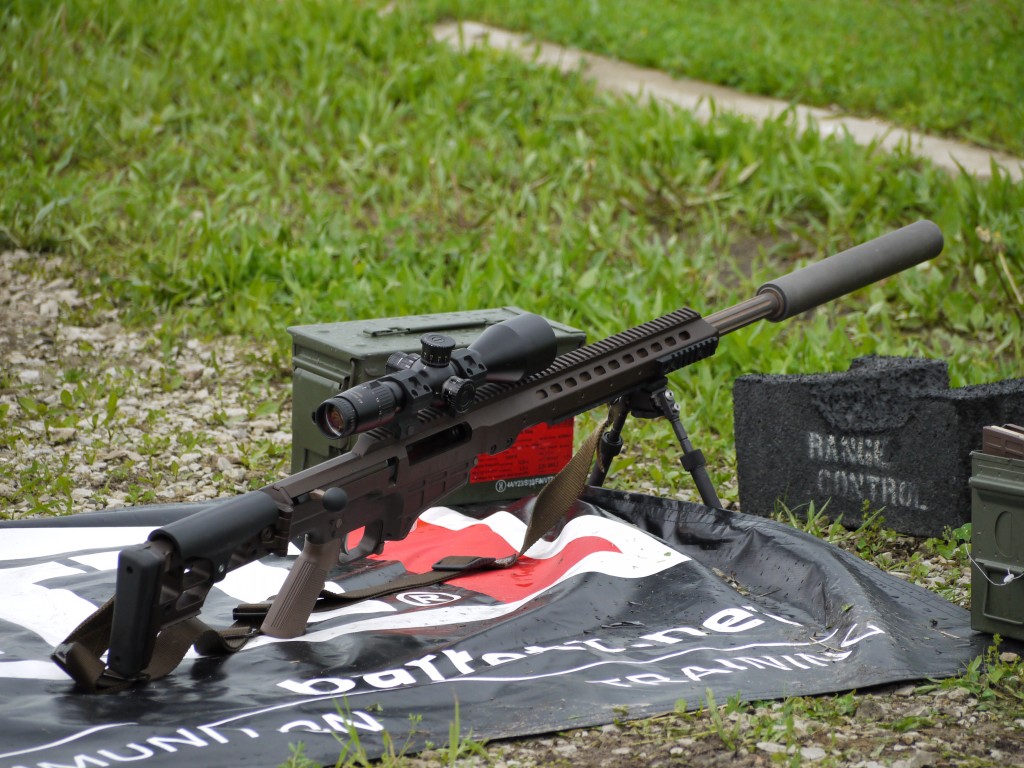
Barrett is best known for their .50 BMG semi-automatic rifles. They also produce some very nice bolt action rifles. Their latest rifle is called the MRAD or Multi-Role Adaptive Design rifle, chambered in .338 Lapua Magnum. Barret trucked their rifle out to the NDIA symposium in Indianapolis (along with a generous supply of ammunition) and let me take a couple shots.
Just like the AR platform, the MRAD is comprised of an “upper” and a “lower” section. The MRAD’s upper is a monolithic rail system with a free floated barrel inside. It accepts a number of different calibers including 7.62 NATO. What makes it even cooler: you can change the barrel, adjust for the different ballistics of the new caliber, and still be within 1 MoA on the target without re-zeroing the scope. Or so Barrett claims.
The upper has a full length rail on the top with a 30 MoA tilt. Thanks to the effect of the increased “baseline” elevation of the barrel, a shooter can use the MRAD’s scope to engage targets much further away. The long rail also means that “operators can mount their in-line NVGs to the weapon system,” or so the sales guy said.
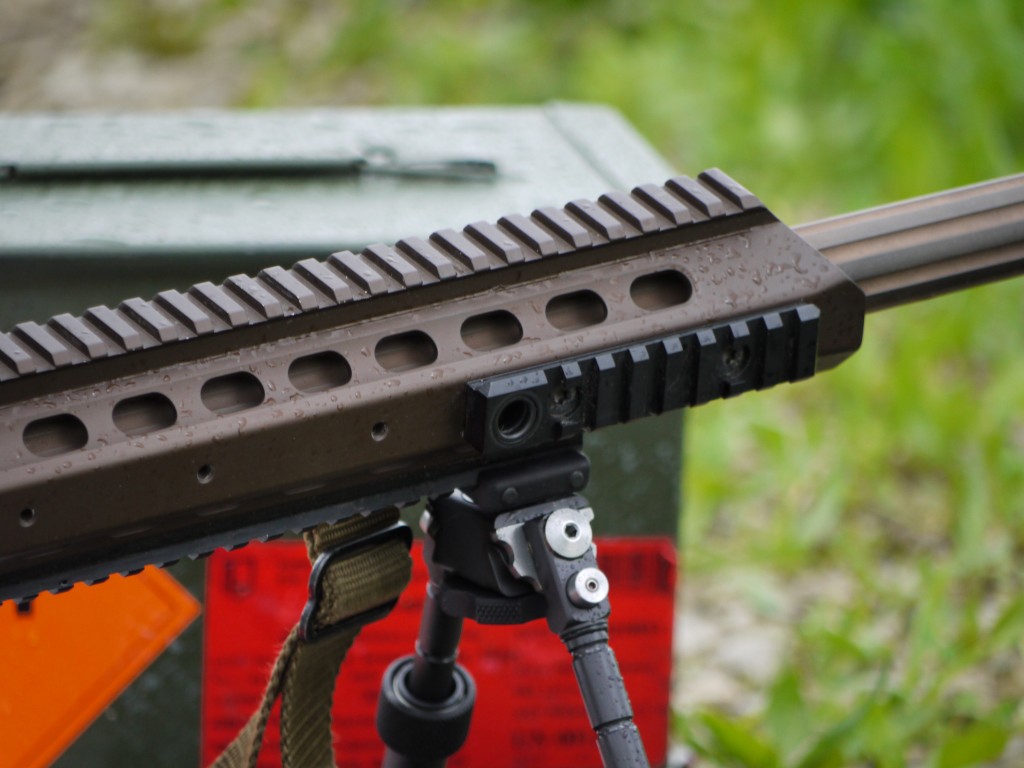 The MRAD’s top rail comes factory fitted. There’s plenty of room for additional accessory rails. You can mount bipods, lights, lasers, coffee makers…
The MRAD’s top rail comes factory fitted. There’s plenty of room for additional accessory rails. You can mount bipods, lights, lasers, coffee makers…
Unlike most of the bolt action rifles, when the MRAD’s bolt is retracted it slides into its own little housing at the end of the receiver. Inside the housing: a self-lubricating polymer bolt guide. When the bolt is closed the self-lubricating piece of magic rotates downward. It completely covers the gaping slot through which the bolt handle slides. The MRAD’s polymer bolt guide acts as a dust cover to keep stuff out of the housing.
I don’t get it. Exposing a rifle bolt to the open air hasn’t caused any major complaints for the last hundred or so. The MRAD bolt’s integrated housing also means that the “upper” receiver needs to be just THAT MUCH longer, interfering with the next nifty feature.
 The lower receiver’s biggest claim to fame: it folds just behind the end of the bolt housing, decreasing the overall length of the rifle. That length would decrease even more if the bolt housing was removed.
The lower receiver’s biggest claim to fame: it folds just behind the end of the bolt housing, decreasing the overall length of the rifle. That length would decrease even more if the bolt housing was removed.
The MRAD’s lower uses a double-stacked detachable magazine. To fit it with an ambidextrous magazine release, Barrett followed the Ruskies, deploying the same magazine catch design found on the AK series rifles. Unlike the AK series, the MRAD’s magazine release is very small and not well-positioned.
The MRAD’s lower also sports an AR style thumb safety, the ability to accept AR grips, fully adjustable cheek and butt plates. Barrett had their trigger set a little light for me, but it’s fully adjustable. (You own it, you tweak it.)
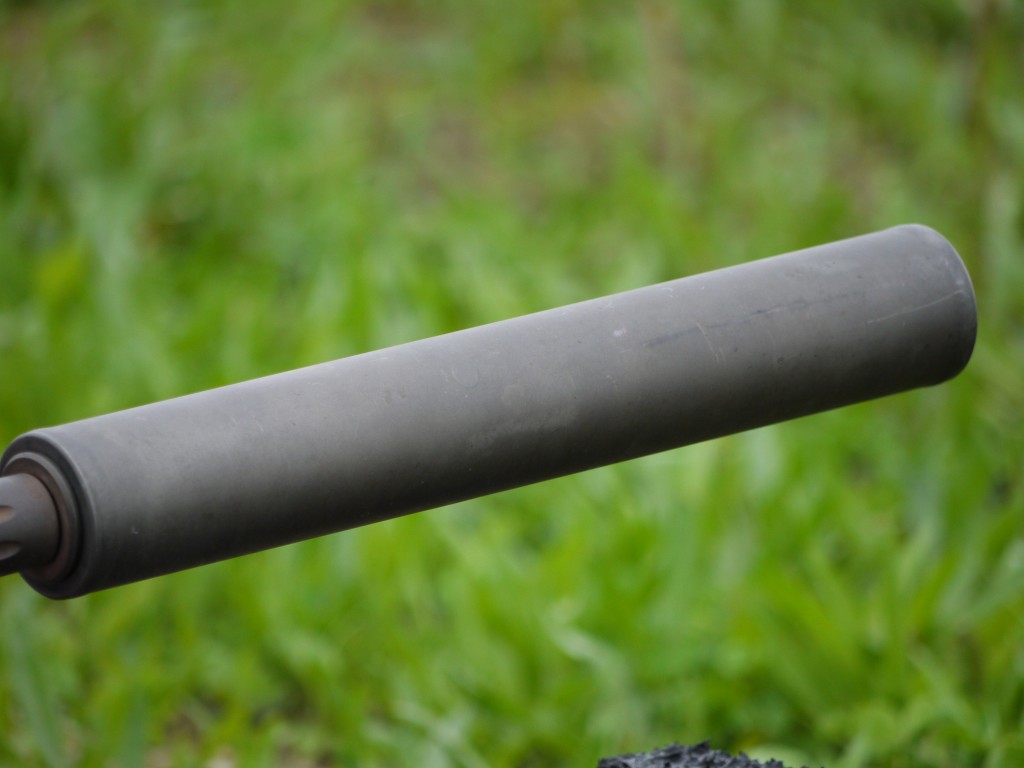 Another of the MRAD’s big selling points: the rifle’s threaded barrel. It can accept anything from suppressors to muzzle brakes to flash hiders. The suppressor won’t make the shot completely silent, but it does make it sound much quieter and slightly “squishy.”
Another of the MRAD’s big selling points: the rifle’s threaded barrel. It can accept anything from suppressors to muzzle brakes to flash hiders. The suppressor won’t make the shot completely silent, but it does make it sound much quieter and slightly “squishy.”
The Barrett MRAD’s recoil is . . . significant. The ArmaLite AR-50 kicks less than this thing, as does a small horse. To be fair, the ArmaLite fiddy has a laughably large muzzle brake and the MRAD doesn’t.
In general, the Barrett MRAD feels good to shoulder. The adjustable stock and cheek plate makes the rifle very comfortable, if not slightly large. Like the AR-50, the MRAD is a ballistic boat anchor. As accurate as this rifle sure is, I couldn’t imagine the MRAD being very easy to move around a range much less the “sandbox.”
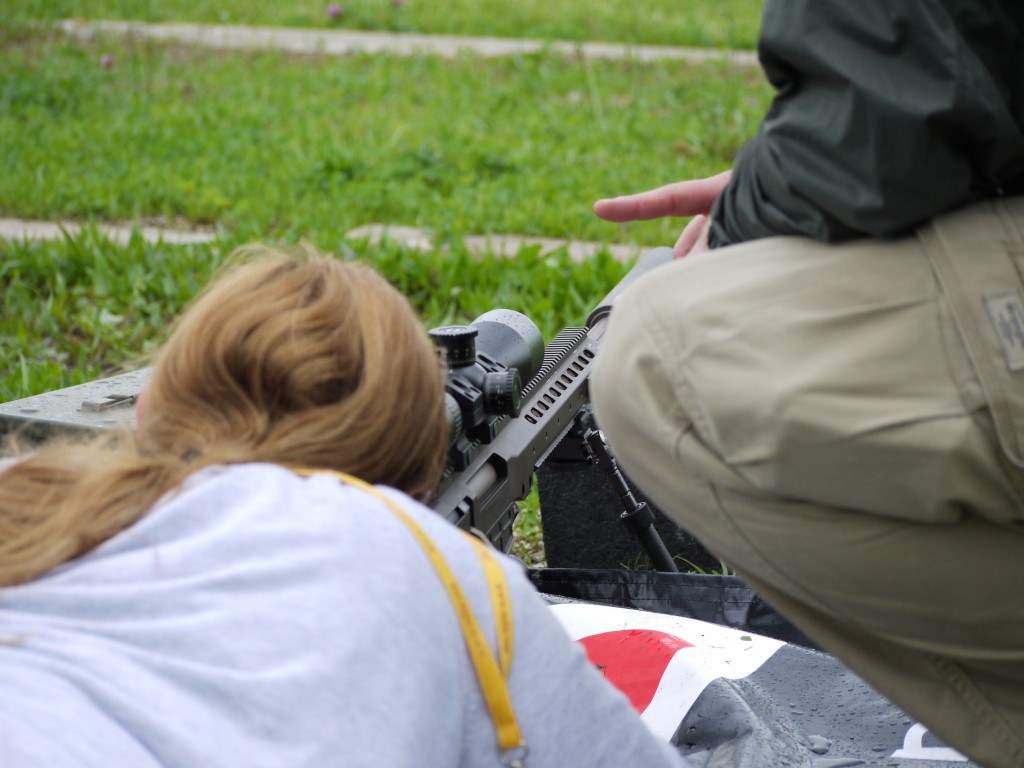 The MRAD does a lot of things well, and a lot of things not so well. But it looks amazing, with a level of accuracy that the military and high end shooters admire and require. The thing weighs as much as a tank, but that’s to be expected for a precision instrument of this type. I’m not entirely convinced I like it yet; there are other ways to spend six grand on guns that would make me happier.
The MRAD does a lot of things well, and a lot of things not so well. But it looks amazing, with a level of accuracy that the military and high end shooters admire and require. The thing weighs as much as a tank, but that’s to be expected for a precision instrument of this type. I’m not entirely convinced I like it yet; there are other ways to spend six grand on guns that would make me happier.
Barrett’s promised to send an MRAD to TTAG for testing and evaluation. Look for a full update and accuracy test ASAP.
Specifications
Caliber: Multiple (tested in .338 Lapua Magnum)
Barrel: 24.5″ 1:10 right hand twist
Size: 46.9″ to 39.9″ folded
Weight: 14.8 lbs. empty
Operation: Bolt action
Finish: Brown
Capacity: 10+1 with removable magazines
Civilian MSRP: $6,000
Ratings (Out of Five Stars)
All ratings are relative compared to the other weapons in the gun’s category.
Accuracy: * * * * *
From what I could tell, it seems very accurate. At least, it FELT accurate. All I could determine that it’s “minute of crane hulk” at 600 yards.
Ergonomics: * * *
This rifle feels great, but the magazine release is a little wonky for me. The bolt is also at an interesting angle, and I’m not sure if I like it. The grip and safety are straight off an AR, so they feel about right.
Ergonomics Firing: * * * * *
Recoil feels strong but correctly placed, and the trigger feels good. I have no complaints about the ergonomics of the fire controls.
Reliability: N/A
I didn’t have enough time to test the reliability, but given the operating system and other reports on this rifle I’d say it’s pretty good.
Customization: * * * * *
The rifle not only has a full length top rail, but it also has slots to mount other rails or accessories directly to the rifle. You can change the grip, the side the safety is on… Tons of stuff!
Overall Rating: * * * *
A damn fine rifle, if slightly heavy and with odd features. A large financial commitment but for some, it’s Barrett or nothing.
[DISCLAIMER: The guns I fired at the NDIA (National Industry Defense Association) symposium are generally not available to the public. I didn’t get a whole lot of time to give the weapons a full and complete review. But I did have enough trigger time to get a general idea of how the guns feel and handle.]

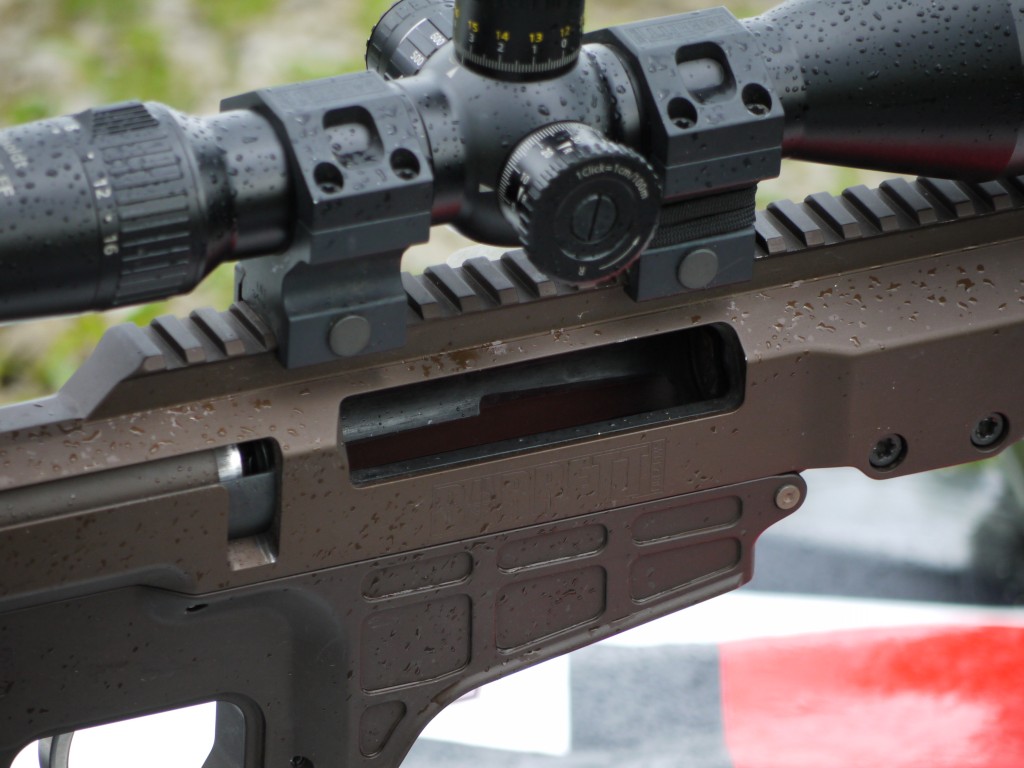



I think I saw this at a gun show last sat. I admit, though .338 guns usually fascinate me, the SCAR-H sitting next to it was drawing way to much of my attention and mental capacity as I considered any and all possible ways to buy it and not land in divorce court. Some day SCAR-H, you will be mine.
But yah, saw a new .338 that as I recall looked just like this, and was priced at just under 6K (as in $5995), might have been this one. Sorry now I didn’t take a closer look.
6K is a steep price for entry…. But it only gets worse from there.. ammo runs $60-$150 per 20. The .338 Lapua Magnum is a great cartridge so long as you have a 1000 yard (or longer) range and someone else is paying for the ammunition!
I enjoyed reading this review. It was factual and separated personal impressions from facts, all the while giving us all the information that the reviewer had at his disposal. Very professional.
Shooting in the full prone position was always one of my least favorites over my 15 year military service, I would rather stand in a foxhole two feet deep in nasty red Georgia clay/mud/water, personally!
Is the bolt movement smooth? I got my hands on a 98B, which is very similar in design, and the bolt movement was pretty smooth inside that polymer sleeve. But that’s just my opinion, and I have very little bolt-gun experience. Curious about your impressions on the ease of manipulating the bolt (or lack thereof, if this is the case).
The bolt movement did seem pretty smooth. Not as smooth as the AR-50 (which used an entire tub of lard as lubricant), but definitely smoother than my Mosin. Pleasant would be the word I used to describe it.
This may be a little late, but the MRAD’s twist rate for .338LM is (and has always been) 1 in 9.35″. In other words, TTAG, “The data on the Migs is inaccurate.”
Comments are closed.